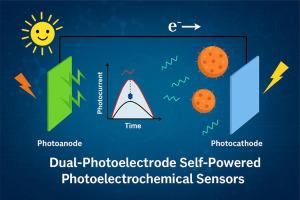Dual-photoelectrode self-powered photoelectrochemical sensors
IF 12
1区 化学
Q1 CHEMISTRY, ANALYTICAL
引用次数: 0
Abstract
The development of advanced photoelectrodes and innovative signal amplification strategies holds significant promise for achieving high sensitivity in photoelectrochemical (PEC) analysis. Notably, dual-photoelectrode self-powered PEC sensors represent a significant advancement in biosensor technology, offering enhanced sensitivity, lower detection limits, and greater resistance to interference. By incorporating both a photoanode and photocathode within a PEC system, these sensors eliminate the need for external power sources while enhancing signal stability. Their design facilitates efficient electron transfer and superior photoelectric conversion, making them particularly well-suited for portable, cost-effective applications in environmental monitoring, clinical diagnostics, and food safety. This novel approach addresses the limitations of traditional PEC sensors, paving the way for high-performance analytical tools that can be used in real-world scenarios. This review first explores the latest advancements in the development of dual-photoelectrode self-powered PEC sensors. It then provides a detailed summary and discussion of the various types of these sensors, focusing on their current output, power generation capabilities, and potential applications. Additionally, dual-photoelectrode systems are categorized based on their photoactive materials, emphasizing the importance of finding a suitable Fermi energy level difference between the photoanode and photocathode materials to serve as the driving force. A systematic comparison of these materials is also provided, and current developments identify the primary challenges that must be addressed. This comprehensive overview provides valuable insights into the current state of dual-photoelectrode self-powered PEC sensors, promoting the development of rapid, portable, and miniaturized detection devices that can operate without external power sources.

双光电极自供电光电电化学传感器
先进的光电极和创新的信号放大策略的发展为实现光电化学(PEC)分析的高灵敏度提供了重要的希望。值得注意的是,双光电极自供电PEC传感器代表了生物传感器技术的重大进步,提供了更高的灵敏度,更低的检测限和更强的抗干扰性。通过在PEC系统中结合光阳极和光电阴极,这些传感器消除了对外部电源的需求,同时增强了信号的稳定性。它们的设计促进了高效的电子转移和卓越的光电转换,使它们特别适合于环境监测,临床诊断和食品安全中的便携式,具有成本效益的应用。这种新颖的方法解决了传统PEC传感器的局限性,为可用于实际场景的高性能分析工具铺平了道路。本文首先综述了双光电极自供电型PEC传感器的最新研究进展。然后对各种类型的传感器进行了详细的总结和讨论,重点介绍了它们的当前输出、发电能力和潜在应用。此外,根据其光活性材料对双光电极系统进行了分类,强调了在光阳极和光电阴极材料之间寻找合适的费米能级差作为驱动力的重要性。还对这些材料进行了系统的比较,目前的发展确定了必须解决的主要挑战。这一全面的概述为双光电极自供电PEC传感器的现状提供了有价值的见解,促进了快速、便携式和小型化检测设备的发展,这些设备可以在没有外部电源的情况下工作。
本文章由计算机程序翻译,如有差异,请以英文原文为准。
求助全文
约1分钟内获得全文
求助全文
来源期刊

Trends in Analytical Chemistry
化学-分析化学
CiteScore
20.00
自引率
4.60%
发文量
257
审稿时长
3.4 months
期刊介绍:
TrAC publishes succinct and critical overviews of recent advancements in analytical chemistry, designed to assist analytical chemists and other users of analytical techniques. These reviews offer excellent, up-to-date, and timely coverage of various topics within analytical chemistry. Encompassing areas such as analytical instrumentation, biomedical analysis, biomolecular analysis, biosensors, chemical analysis, chemometrics, clinical chemistry, drug discovery, environmental analysis and monitoring, food analysis, forensic science, laboratory automation, materials science, metabolomics, pesticide-residue analysis, pharmaceutical analysis, proteomics, surface science, and water analysis and monitoring, these critical reviews provide comprehensive insights for practitioners in the field.
 求助内容:
求助内容: 应助结果提醒方式:
应助结果提醒方式:


